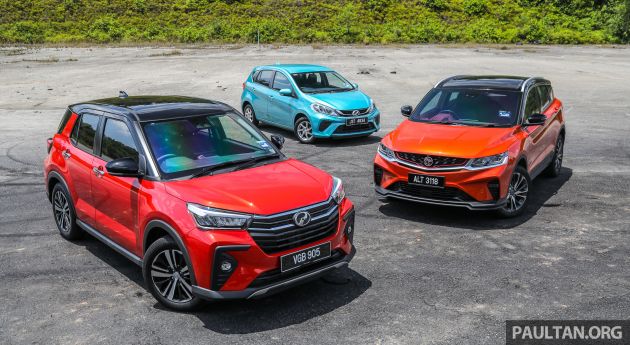So how big is it? That’s one of the most popular questions about the new Perodua Ativa, and one that we also had before seeing the new SUV in the metal. Sometimes, the bald figures can only tell so much, and a new car needs to be compared visually against the mental markers we already have.
With that, we bring you a gallery of the Ativa with two other cars. One is the Myvi, Perodua’s perennial best seller and a size reference that everyone will get. The other car is the Proton X50.
As with most national brand new products, the market automatically pitches a rival from the other camp – this is not always a like-for-like comparison. Remember the Proton Savvy and the first-gen Myvi? While both were five-door hatchbacks, they were very different in size and drive. It’s the same case here. Both are B-segment SUVs, but the X50 is bigger, more sophisticated and of course, more expensive than the Ativa. More on these two later.
The Ativa is 4,065 mm long, 1,710 mm wide and 1,635 mm tall. That makes it larger than the JDM Daihatsu Rocky in all directions – 70 mm longer, 15 mm wider and 15 mm taller. The larger footprint, especially the length, is due to the more streamlined design of Perodua’s bumpers, as opposed to the sharp cut of the Rocky. The Ativa’s lines look more natural as a result.
The Perodua’s height advantage is from the Malaysia-specific suspension, which besides being firmer than Daihatsu’s comfort-focused setup, also raises the ground clearance to 200 mm. Wheelbase is 2,525 mm.
Let’s start with Ativa vs Myvi. While some say it’s an “Axia SUV” (by the way, they’re completely not related, down to the platform), the Ativa is 170 mm longer than the sub-4m Myvi, never mind little brother Axia. It is also 120 mm taller than the Myvi, and the extra height is quite apparent when both are put side-by-side.
Perhaps even more obvious is how the Myvi looks a fair bit wider than the Ativa, although the figures show just a 25 mm advantage for the hatchback. Look at the windscreens of both cars. This visual effect is down to design and proportions – the Ativa is of the more upright and squarish SUV variety, which fits both Daihatsu’s trend and the Rocky name. A C-HR it is not.
The side profile shot also shows the Ativa’s straight bonnet vs Myvi’s raked front. By the way, the Ativa’s 2,525 mm wheelbase is 25 mm longer than the Myvi’s. On a side note, we didn’t have the top Myvi AV on hand, hence this 1.3G for pics, but the dimensions are similar.
The Ativa’s height advantage coupled with its upright profile gives it a distinct SUV look – as opposed to a raised regular hatchback style like Subaru XV – which we suppose is good thing, as “SUV” is a selling point when you’re trying to tempt non-national B-segment sedan buyers. There’s a premium attached to SUVs in the market, which is why everyone is getting on the bandwagon.
Perodua president and CEO Datuk Zainal Abidin Ahmad described the Ativa’s size as “A-segment to small B-segment SUV” and that sounds about right when you put it next to the Proton X50, which fits into the typical B-SUV size template along with cars like the Honda HR-V. At 4,330 mm long and 1,800 mm wide, the X50 is 265 mm longer and 90 mm wider than the Ativa, and its 2,600 mm wheelbase is 75 mm longer.
All these numbers look pretty big, and it’s also noticeable in the metal. However, the Ativa is 26 mm taller and its ground clearance is the biggest of the trio here (196 mm for X50). The latter is obvious in the rear shot you see above. The high GC goes well with the more traditional SUV look of the Ativa, and that should be what many would want in an SUV, likely their first.
So, we can conclude that the Ativa has a smaller body than a typical B-SUV, and the design/proportions is more upright and traditional SUV. However, that does not mean that the cabin is small. While rear legroom is behind the Myvi and X50 here (the Proton’s seats are more comfortably shaped as well, even if headroom isn’t generous), the P2 SUV’s boot space of 369 litres beats the larger X50’s 330L, and Perodua achieves it with a full size spare tyre with matching wheel (space saver for X50). From first impressions, the Ativa’s aircon feels stronger, but the X50 has rear vents.


The Ativa’s boot floor has two levels – the “lower ground floor” (my own term) gives maximum height and capacity, while ground floor gives you 303 litres. The latter allows for an almost flat loading bay when the 60:40 rear seats are folded. The Myvi’s boot is 277 litres, by the way. With a full sized spare and large boot, the Ativa is balik kampung ready.
If the Ativa’s size is in between the Myvi (RM41,292 to RM52,697) and the Proton X50 (RM79,200 to RM103,300) so is its price range of between RM61,500 to RM72,000. All prices are on-the-road excluding insurance, with sales tax exemption (until June 30).
As previously pointed out, the Ativa AV’s spec advantage over the base X50 Standard – which is over RM7k costlier than the P2 – is massive. The Proton has body and engine size (1.5T vs 1.0T) on its side, but it comes with only four airbags, never mind ADAS driver assist features, which are reserved for the RM103k Flagship.
Meanwhile, the Ativa has six airbags, ASA 3.0 with AEB, and Lane Departure Warning/Prevention as standard across the board. The Ativa AV has the full Level 2 semi-autonomous package with Adaptive Cruise Control, Lane Keep Control, Blind Spot Monitor and Rear Cross Traffic Alert added. The base X gets Auto High Beam for its LED headlamps, while X and AV variants receive Adaptive Driving Beam with sequential turn signals and cornering lamps.
Looks are subjective, but for us, the X50 is ahead of the Ativa in the style stakes, and the Proton’s interior is more premium in both design and materials. The Flagship’s red dashboard, chrome edged screen and high centre console full of buttons all combine to make this cabin as special as one can be for RM100k. But it better be, seeing that the top X50 is over RM30k costlier than the Ativa AV – you can buy an Axia with the difference.
On the other end of the scale, is the Ativa worth the premium over the Myvi? That might be a question one would ask if he/she saw the Myvi AV alongside the base Ativa X, which is RM9k costlier. Sure you get an SUV body, but the X looks rather basic outside (thick tyres) and especially inside, where it is shorn of the AV’s dual screens, steering buttons and silver/red accent trim.
However, kit aside, the Ativa is a better car underneath, with a more advanced DNGA platform, turbo engine and CVT gearbox. There’s also the improved ASA 3.0, LDW and AHB, so there’s plenty of substance for the RM9k premium, even if the X offers not much evidence, style-wise. As for the RM20k difference between the Myvi AV and Ativa AV, the SUV offers a lot more kit, but for not insignificant money either, so buy what you can afford.
In any case, Perodua says that the Ativa is expected to only affect 5% of Myvi sales, and the target market for both models are different – armed with an SUV body and unprecedented levels of kit/safety at this price point, the Ativa is meant to draw punters away from non-national models. Think B-segment players Honda City (RM74,191 to RM86,561), Toyota Vios (RM74,623 to RM95,294) and Nissan Almera (RM79,906 to RM91,310), all of which have been recently refreshed.
So there you go, the size and price differences of the new Perodua Ativa next to the Myvi and Proton X50. There was a gap between the Myvi and the X50 for Perodua to exploit (Aruz is a different kettle of fish, for a specific type of user), and the market leader has swooped into the RM60k-RM70k market with the Ativa. These three models you see here illustrate “you get what you pay for” nicely, and as consumers, we should be happy with more options. Your money, so what’s your choice?















Our full coverage of the launch of the Perodua Ativa
- 2021 Perodua Ativa launched in Malaysia – RM62k to RM72k
- 2021 Perodua Ativa – differences from Daihatsu Rocky and Toyota Raize
- 2021 Perodua Ativa – GearUp accessories detailed
- 2021 Perodua Ativa won’t have AWD, will have 95% local content
- 2021 Perodua Ativa gets five-star ASEAN NCAP safety rating
- FIRST LOOK: 2021 Perodua Ativa detailed walk-around
- Perodua hints at electrification plans for the future
- 2021 Perodua Ativa – only minor cannibalisation of Aruz, Myvi sales expected
- DRIVEN: 2021 Perodua Ativa – first impressions
- 2021 Perodua Ativa – how D-CVT is different from other CVTs
- 2021 Perodua Ativa – DNGA platform explained
- 2021 Perodua Ativa – 1KR-VET 1.0L turbo three-cylinder deep dive
GALLERY: 2021 Perodua Ativa AV 



































































































































































GALLERY: Proton X50 1.5 TGDi Flagship 













The post 2021 Perodua Ativa vs Myvi vs Proton X50 – size and price compared, where does the new SUV stand? appeared first on Paul Tan's Automotive News.


























































































































































0 Comments